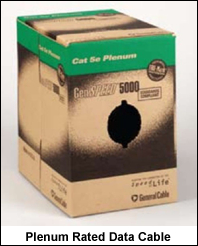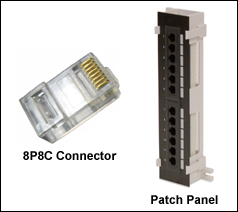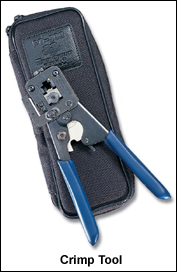Residential Network Cable Installation Recommendations
Posted sometime prior to .
Path Selection
The exterior walls of your premises contain insulation and vapour barriers, which serve a functional purpose. Both (insulation, vapour barrier) are at risk of damage, if you pull cable through these walls. Therefore, it's preferable to route cabling through interior walls, and terminate cables with faceplated outlets. If you really need an outlet placed on an exterior wall, it's best to use an aesthetically pleasing raceway (plastic conduit) affixed to your baseboard, to contain cable(s) that would have otherwise been exposed, and terminate with a discreet surface‑mount box on the baseboard.

Cable Selection
The data cable consists of eight conductors, arranged in four twisted pairs. These conductors are solid copper, in contrast with patch cords (used to connect your devices to the network), which use stranded conductors. Never install stranded conductor cabling in place of solid conductor cabling. Cables differ in terms of their intended application, and have different fire ratings. You want plenum rated (improved fire safety standards) cabling, which is suitable for your environment (Fig. 1).
Data cable is categorized by its performance. Some of the physical characteristics affecting performance are the number of twists per foot in the conductor pairs (each being different); the presence / absence of a pair separator; the presence / absence of foil wraps, and / or braided shielding. The majority of cable installed is Unshielded Twisted Pair (UTP). Some commercial applications require screened / shielded cable, which exists in several configurations.
Category 5e (enhanced) UTP will support Gigabit (Gbps) performance, which is sufficient for most current applications. If you want to pay a premium for Category 6 UTP you can, but it's not necessary, and it's not going to get you to the next performance level (10 Gigabit) anyway.
If you're a trendsetter with exceptional needs, or looking well into the future, you may consider Category 6a (augmented) F/UTP (Foil Twisted Pair), which supports 10 Gigabit performance.
Wiring Standards
There are two relevant TIA / EIA wiring standards (T568A, T568B), which differ in the termination of pairs 2 and 3. Patch panels and outlets are colour labelled for one or both standards. Both ends of the cable need to be terminated per the same standard. In a residential setting, T568A should be used. Termination with 8P8C (8‑Position, 8‑Contact) modular connectors require attention, as they are not labelled.

Termination Options
It is preferable to terminate your cables on a patch panel, where all cables are consolidated (Fig. 2). These solid conductor cables will be protected from bending and other stresses. Patch cords are used between the ports of the patch panel, and the concentration device (ISP Home Hub, gateway / router, switch). Alternatively, cables may be terminated with 8P8C clear modular connectors. However, these remain somewhat vulnerable.

Attics
If you plan to use your attic for the horizontal distribution of cabling, consider the seasonal implications. On a hot (35°C / 95°F) and humid summer's day, conditions in the attic (50°C / 122°F) can be dangerous.
Nothing good happens quickly in the attic. Progress will be slow as you battle with blown‑in insulation. It obscures everything, good and bad; the trusses you want to step on; the central vac pipes you don't. You may encounter security system or telephone cables sitting up off the trusses, like trip wires, that are so inexplicably taut, you'd swear there's a Claymore (mine) on the other end. Congratulations Mr. Home‑Builder, you saved yourself a dollar on cable.
You'll be in there longer than you expect, and if you're a determined soul, you won't come out as frequently as you should. So, strap on a water bottle and use it; fasten a thermometer (Fig. 3) to a truss and reference it; have someone check on you frequently, and take breaks to cool down. With the heat, the absence of airflow, and the rapid dehydration, your condition can decline rapidly (within minutes). A person can perish in there.
If you're not prepared to heed our advice, and you're sending someone else in to do the work for you, consider a nice bereavement card to go with the flowers.

Do It Yourself (DIY) Considerations
Terminating 8P8C clear modular connectors, and
getting a poor crimp yield?
These connectors come in two versions, those intended for stranded
conductors, and those intended for solid conductors. Many retailers don't know the difference.
A connector designed for solid conductor cabling will accommodate stranded conductors. A
connector designed for stranded conductor cabling will NOT accommodate solid conductors. One
connector type straddles the conductor, the other attempts to push through (separate) the strands, of
an expected stranded conductor. Distinguishing one from the other requires a magnifying glass,
and knowledge of the contact characteristics to look for, which vary among manufacturers.
Ignoring the details may lead to frustration, and worse, unreliability.
The primary challenges are overcoming the physical memory of the twisted conductors, and burying all eight conductors equally, and deeply into the connector. Technique matters, and is developed with experience.
Using a $40 crimping tool purchased at a DIY
store?
You may achieve a good crimp yield. Although, you may not. Substandard crimps
have the potential to plague you. When we crimp ten 8P8C
connectors with our $250 crimping tool (Fig. 4), we get a reliable yield of ten.
last modified: 2025.09.02, 17:06 -0400
endeavor-networks.com/articles/residential-network-cable-installation-recommendations.shtml.en-CA
© 1999 – 2025 All rights reserved by the Domain Registrant.